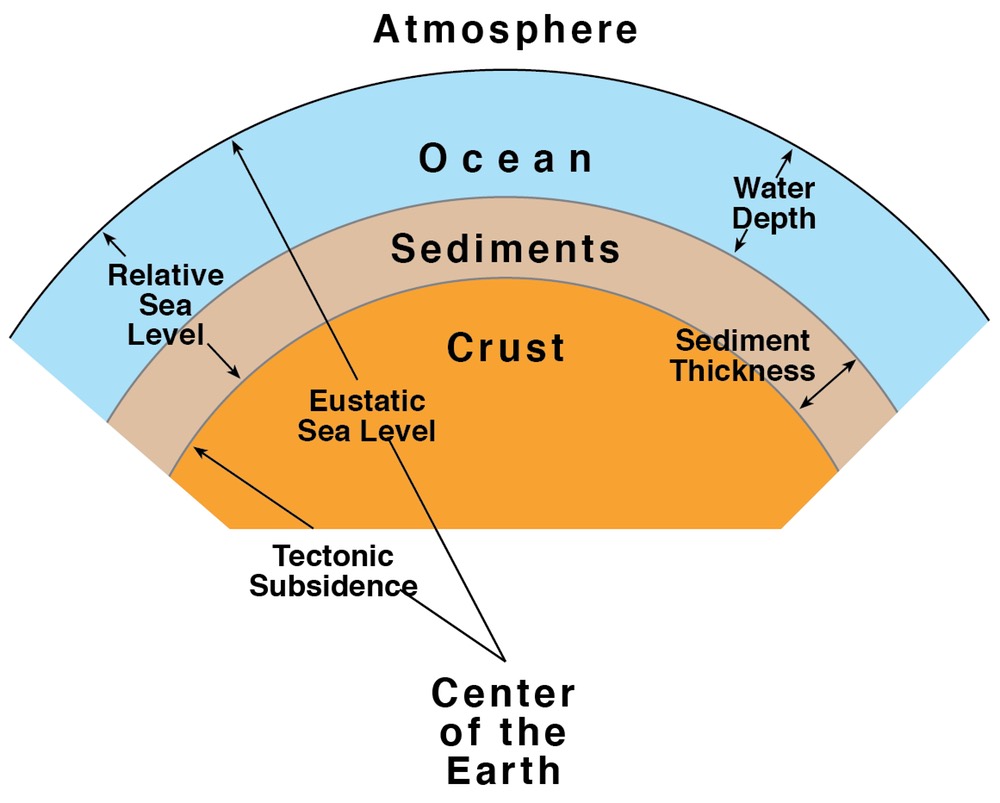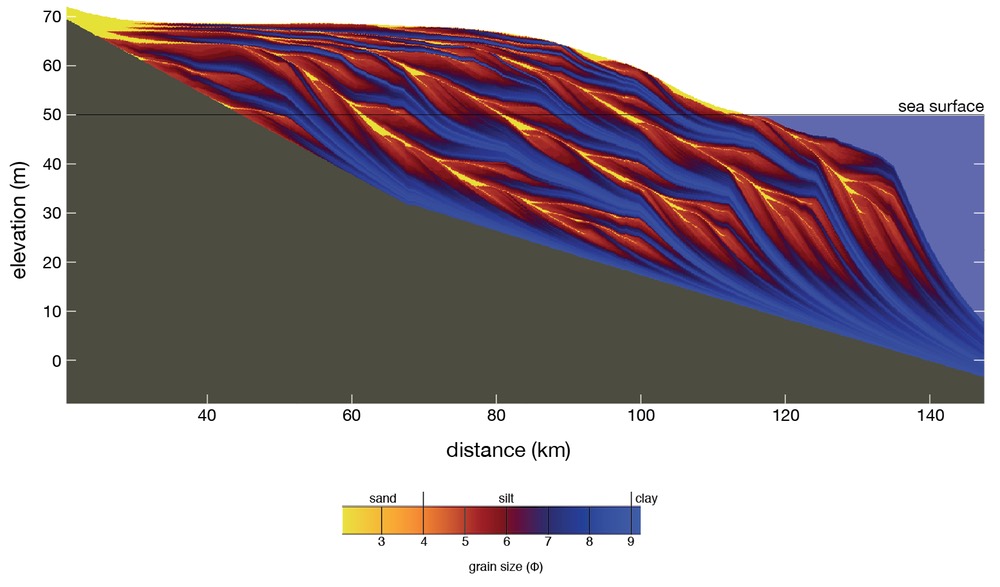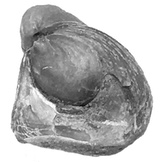Accommodation
The Accommodation Space Equation
Over long time scales (105–108 years), sediment accumulation is controlled by changes in eustatic sea level, tectonic subsidence, and climatic effects on the production of sediment. Some of these terms are often confused, so it is best to start by defining each of them.

Schematic cross-section of Earth, showing definitions of important terms in sequence stratigraphy. Not to scale.
Eustatic sea level is defined as the distance from the surface of the ocean to some fixed reference point, usually taken as the center of the earth. Eustatic sea level can change by changing the volume of water in the ocean or by changing the shape of the ocean basins.
Tectonic subsidence is the movement of the lithosphere from plate tectonic reasons down or up relative to a fixed reference point, again, usually the center of the earth. Tectonic subsidence is a driving force on sediment accumulation, as opposed to the isostatic adjustment of the lithosphere in response to the changing weight of sediment and water.
Relative sea level is the difference between eustatic sea level and tectonic subsidence. It can also be thought of as the up or down movement of the ocean surface relative to the top of the basement, that is, the base of the column of sediments and sedimentary rocks labeled as sediment thickness. Relative sea level is controlled by eustatic motions as well as tectonic subsidence, and is often called accommodation space.
Water depth is the distance from the surface of the ocean to the sea floor. This is sometimes erroneously called relative sea level or sea level.
The vertical motions of the surface of the ocean, the top of the basement, and the top of the sedimentary pile are necessarily linked through what is called the accommodation space equation:
T + E = S + W
where T is the rate of tectonic subsidence, E is the rate of eustatic sea-level change, S is the rate of sedimentation, and W is the rate of change in water depth. These rates are defined such that positive values on the left side reflect an increase in accommodation space, such as tectonic subsidence or eustatic sea-level rise, with negative values indicating a loss of accommodation, specifically tectonic uplift or eustatic sea-level fall. On the right side, these values are defined such that positive values indicate an increase in the vertical thickness of that material (that is, increasing sediment thickness or deepening water depths), with negative values corresponding to losses of that material (e.g., erosion or shallowing of water depth).
The accommodation space equation represents a simple volume balance, with the terms on the left (tectonic subsidence and eustasy) controlling the amount of space that can be occupied by the terms on the right (sediment and water). In this form, however, the equation is an approximation because it does not include secondary effects. For example, increases in sediment thickness or water depth drive isostatic subsidence of the lithosphere, creating additional space. Increases in sediment thickness cause compaction of underlying sediments, also creating additional space.
Solving this equation can be a challenge. Some of the terms are straightforward to measure, such as using section measurement to get sediment thickness through time or by using facies analysis to estimate water depth through time. More difficult are the rates of eustatic sea-level change and tectonic subsidence, because their effects cannot be distinguished in a single stratigraphic column. In other words, there is no unique solution to this equation for a single stratigraphic column, and it is impossible in most cases to ascribe water depth or sedimentation changes to eustasy or tectonics without having regional control or outside information. In most cases, we will use changes in sediment thickness and water depth to understand how accommodation (the sum of eustasy and tectonic subsidence) changed over time.
The accommodation space equation can also be used to simulate stratigraphy, which can be used to test hypotheses about the controls on sequence-stratigraphic architecture. For example, by specifying by changes over time in the rates of tectonic subsidence, eustasy, and sediment input, changes in water depth can be solved for. Sedimentary basin models can do this in one dimension to generate a stratigraphic column, two dimensions to generate a cross-section, or three dimensions to generate a volume of sedimentary deposits.

Sedimentary basin simulation using Sedflux. Four sequences, each of 2 m.y. duration, are simulated on a siliciclastic passive margin. Colors correspond to grain size.
Causes of Eustatic Sea-Level Change
Changes in eustatic sea level arise from either changes in the volume of ocean basins or changes in the volume of water within those basins.
The volume of ocean basins is controlled by continental collision and breakup, the rate of seafloor spreading, and secondarily by sedimentation in ocean basins. Continental collision and breakup change the average thickness of continental lithosphere, which therefore changes the average area of continents, and in turn the average area of the ocean basins. Rates of seafloor spreading change ocean basin volumes because young and hot oceanic lithosphere is more buoyant than old and cold oceanic lithosphere, and therefore floats higher on the asthenosphere, displacing ocean waters onto continents. Filling of ocean basins with sediment derived from continental weathering is a relatively slow and minor way of changing ocean basin volumes and can produce meters to tens of meters of eustatic change over tens to hundreds of millions of years.
The volume of seawater is dominantly controlled by glaciation, ocean temperature, and the volume of groundwater and lakes. Continental and mountain glaciation is the most efficient and rapid means of storing and releasing ocean water, but sea ice has no effect on sea level. Continental glaciation is more important than mountain glaciation, and it can drive high amplitude (10–100 m), high frequency (1–100 k.y.) eustatic changes. Changes in ocean temperature affect the volume of seawater through the expansion of water at temperatures higher than and lower than 4 °C. Because the depths of the oceans average around 5 km, small changes in the temperature of seawater can cause substantial changes in ocean water volume. Changes in water temperature can drive a few meters of eustatic change over short time scales (0.1–10 k.y.). Storage of water on continents in rivers, lakes, and groundwater provides the third way of changing the volume of water in oceans. Over relatively short time scales (0.1–100 k.y.), changes in the amount of water sequestered on the continents can produce up to a few meters of eustatic change.
Eustatic sea level is also affected on geological time scales by changes in the distribution of mass on Earth, caused by mantle convection and plate tectonic motion. Regional redistributions of mass affect the position of the geoid, an equipotential surface of gravity towards which the surface of the ocean will tend to equilibrate. As a result, eustatic sea level is not the same elevation over the entire surface of the Earth.
Over shorter time scales, tides, winds, ocean currents, and differences in ocean temperature can create local variations in sea level. These can be especially important on human time scales, such as sea-level rise produced by climate change.
Causes of Tectonic Subsidence
Tectonic subsidence is also called driving subsidence, and it is distinguished from the isostatic effects of sediment and water loads. Tectonic subsidence, as its name implies, is driven by tectonic forces that affect how continental lithosphere floats on the asthenosphere. Four main mechanisms that affect this isostatic balance and therefore drive tectonic subsidence include stretching, cooling, loading, and asthenospheric upwelling and downwelling.
Stretching of continental lithosphere in most situations results in the replacement of relatively light continental lithosphere with denser asthenosphere. The resulting stretched and thinned lithosphere sinks, causing tectonic subsidence. In some cases, where the mantle lithosphere is stretched more than the crust, stretching can cause uplift. Stretching occurs in several types of sedimentary basins including rifts, aulacogens, backarc basins, and cratonic basins.
Cooling commonly goes hand-in-hand with stretching. During stretching, continental lithosphere is heated, becomes less dense, and tends to uplift from its decreased density (the net effect in a stretched and heated basin may result either in uplift or in subsidence). As continental lithosphere cools, it becomes denser and subsides. Because cooling subsidence decreases exponentially with time, it can be a source of subsidence hundreds of millions of years following rifting. Cooling subsidence is especially important on passive margins and in cratonic basins.
Tectonic loading can also produce subsidence. The additional weight of tectonic loads such as accretionary wedges or fold and thrust belts causes continental lithosphere to sink. Because the lithosphere flexes under these loads, the subsidence occurs not only immediately underneath the load, but in broad region surrounding the load. Tectonic loading is particularly important in orogenic regions such as foreland basins.
Asthenospheric upwelling and downwelling are increasingly recognized as controlling uplift and subsidence of continental lithosphere. These effects are especially important because they occur in many tectonic settings, including passive margins, where they can generate important regional variations in subsidence rates.

